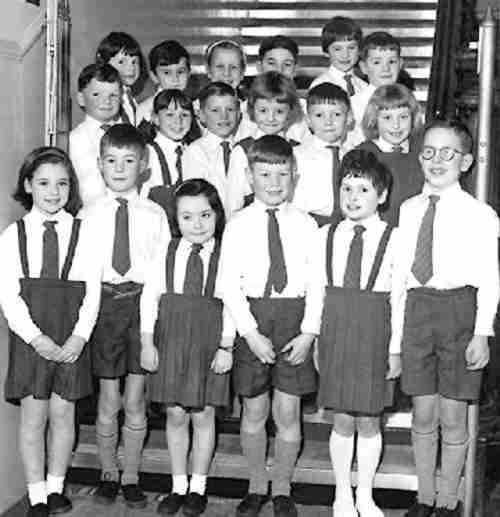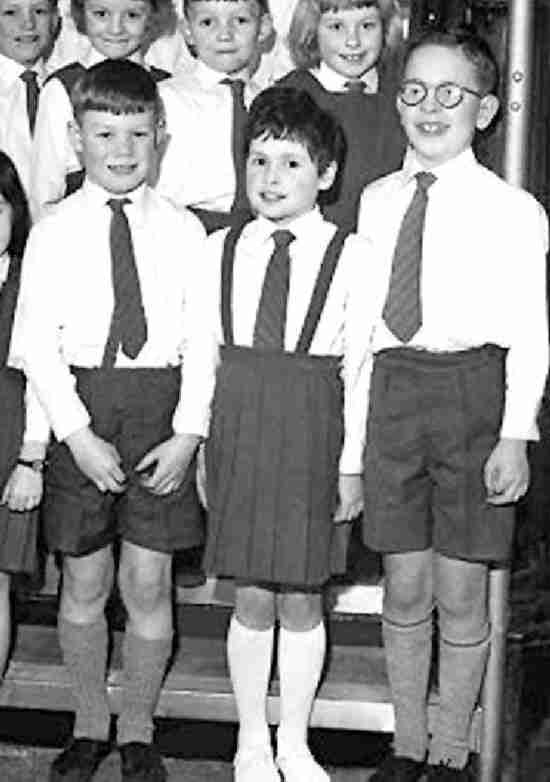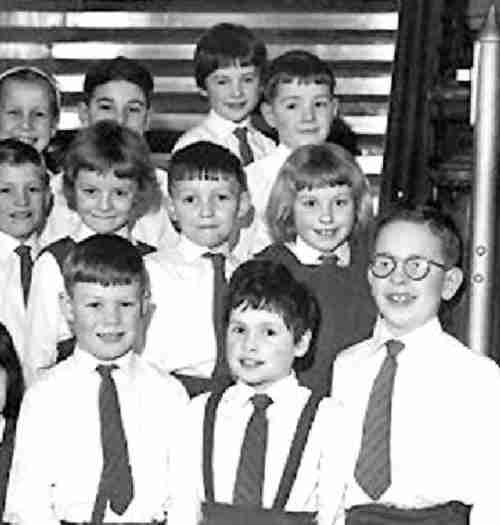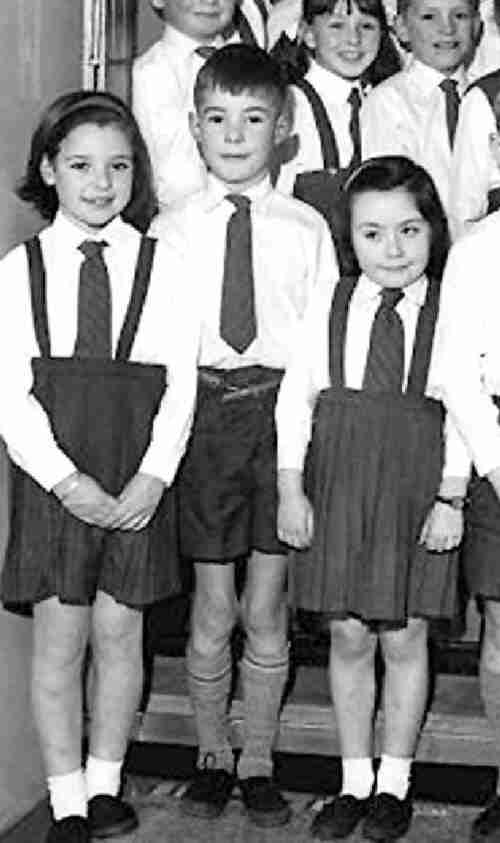
Scottish School Uniform: Individual Schools--Jean Street Primary: 1966

Figure 1.--Many primary schools in Scotland, as in England, adopted simple school uniforms in the 1960s. The children here at the Jean Street school wear white shirts and ties. The boys wears short trousers and grey kneesocks. The girls mostly wear suspender skirts and white socks.
|
The students at the Jean Street Primary School, a school near Glasgow, in 1966 wore school uniforms. The Jean Street school looks to be a state primary school. HBC is not sure when the uniform was introduced, but it was probably the 1960s. The younger children, both boys and girls, wore white shirts and ties. The boys wore grey short trousers, and grey kneesocks. The girls mostly wore grey suspender skirts and white socks. Information is not available on the older children, but the uniform was probably the same for all of the children at the school.
Age
A Scottish primary school is for chilren about 6-11 years. Children from this school would move on to seconary school at about age 11 years. The older children would begin their last year of primary school at age 10 years, but many would turn 11 years before the end of the school year. The children in this 1966 photograph look to be some of the yonger children at the school, probably the 7-year olds. I'm not sure what form this would have been or indeed even if the class is called a form.
A HBC reader reports that he only have first-hand knowledge of
the system in Wales, although he thinks it was the same in England and it may have applied also in Scotland. The first 2 years of primary education were called "Infants School" (He think in the U.S. the German word "Kindergarten" may be use.) [HBC note: Not all U.S. school disticts have Kindergarten. It is the year before 1st grade, usually with children about 5 years old.] He thinks that in the U.K. that classes for the younger children were called infants 1 and 2. After Infants School came Junior school (starting at age 7) when classes were called Standard 1, 2, 3 and 4. The British reader reports that "When I was in school in the late 40's and 50's infants and junior schools were normally separate schools with their own head teachers and staff, although they were usually housed in the same building or on the same campus. As the years have passed, the trend has been to combine
infants and juniors into primary schools under one head teacher. These days, classes are normally named from year 1 (age 5/6) onward, so that what used to be form 1 in a secondary school is now known as year 7. I find it all very confusing, but fortunately I have no connection with the education system."
Location
The Jean Street Primary is located at Greenock near Glasgow. in Scotland. It is quite usual to find schools named from the road in which they are--not very imaginative, but perhaps functional.
Garments
Boys at the Jean Street Primary wore a simple standard British school uniform of striped tie, white shirts, grey short troysers, and grey kneesocks. On colder days, many of the children probably would have worn jumpers. No exceptions appear to have been permitted. The girls' uniform, however is somewhat more varied.

Figure 2.--The chilren wear white shirts for the photograog, but may have worn grey shirts for every day. The boys wear grey kneesocks, the gorls wehite ones. Note that some boys wore kneesocks with the school color bands while others wore plain grey kneesocks.
|
Caps
None of the boys wear caps in the photograph of course because it was an inside photograph. HBC believes that by the 1960s it was unlikely that the school uniform included the traditional peaked cap. Some boys at Scottish primary schools in the 1950s might have still worn peaked caps. but hBC has few details at this time.
Blazers
None of the boys wear blazers. While private schools for primary-age children and secondary schools usually required blazers, they were not common at primary schools. A few schools did have them, but this was the exception rather than the rule. The cost of a blazer meant that it was not practical for many state primary schools.
Shirts
All of the children in their class photograph wear white long sleeved shirts. The fact that they almost all of the children do not wear jumpers suggest that the photograph was taken around May or June when the weather was realtively warm. This means that they probably did not have short sleeved shirts for school. Grey shirts were more commonly worn for school in the 1960s as they did not show stains and dirt like white shirts. The chilren may have ha white shirts for special occasions like the school photograph. Note that the girls appear to be wearing the same style shirt as the boys with pointed collars rather than the blouses with Peter Pan collars often worn by schoolgirls.
Ties
All of the children, both boys and girls wear the same stripped tie. I'm not sure what color it was. It looks to have been a colored tir, perhaps red, with a thin black stripe.
Jumpers
Only one of the children, one of the girls, is wearing a jumper (sweater) for the photograph. It is likely that the uniform did include jumpers which were undoubtedly commonly worn in Scotland. It is unclear if the jumper the one girl is wearing was the school jumper, although it probably was or she would have been asked to take it off. She wears a dark colored jumper--perhaps blue. Unlike many school jumpers it did not have a "V" neck, but rather a horizonal front. There was no school trim on the jumper.

Figure 3.--The girls, unlike the boys, appear to had a more varie uniform. Most of the girls wear suspender skirts. One girls wear a dark jumper with a square front. Other girl appears to be wearing a gym slip.
|
Trousers
All of the boys appear to be wearing grey school short trousers. The uniformity means that it must have been a school rule. This must hace been a school rule. The shorts the boys are wearing appear to be grey Terelyn shorts. Some of the shorts appear to be the ones with front tabs and presumably elasticized back. One boys wears what looks to be a snake belt, but it is to big for him.
Gym slips
The girls mostly wear grey suspender skirts. One girl, however, cane to school in a gym slip uniform. This may have been the winter uniform, or less likely, the girls had an option as to what they wore.
Kilts
Although the Jean Stree School is a Scottish school, there is no indication that any of the boys were wearing kilts. I'm not sure if kilts were permitted, but they were not common at any Scootish primary school known to the authors in the 1960s. Kilts were expensive and reserved for dress occasions. They were most commonly found at private schools.
Socks
All of the boys wear grey kneesocks. Some have colored top socks. As tthe boys seem to be wearing the same colored tops, they presumably in the school colors. The boys have all smartly pulled up their socks for the photograph. The girls, however, wear white socks. While the girls all wear white socks, they appear to have been able to choose ankle or kneesocks.

Figure 4.--The boy here wears shorts with belt loops. His belt, however, looks a bit large for him.
|
Shoes
All of the boys are wearing black lace-up shoes. As they all have them, it was presumably a school rule. None of the children are wearing sandals. As these are the younger children, the ones most likely to war sandals, it seems like sandals were not commonly worn. Althougg they could have been asked to wear lace up shoes for the school photograph.
Season
This photograph was probably taken in May or June. Otherwise they would have been likely to have been wearing their jumpers. All of the boys appear to be wearing shortpants. HBC is unsure if there were any seasonal changes. Given that it was 1966, it is probable that the boys wore the same uniform in the winter as well as the summer term. Of course in the winter they would have had warm coats and jumpers.
Regulations
This state school clealy had a school uniform regulation and strictly enforced it. It is always easy to tell how the uniform regulation is being enforced. If there all the chilren are properly kited out, it means that the school is giving some attention to enforcuing the regulation. Children do not come all dressed alike by accident, the teachers have to give some attention to enforcing the rules. The boys uniform was grey shirt, stripped tie, grey short trousers, grey kneesocks, and black lace-up shoes. Presumably there was akso a grey jumper. None of the children appear to be wearing unauthorized items.
Christopher Wagner

Related Chronolgy Pages in the Boys' Historical Web Site
[The 1880s]
[The 1930s]
[The 1940s]
[The 1950s]
[The 1960s]
[The 1970s]
[The 1980s]
Related Style Pages in the Boys' Historical Web Site
[Long pants suits]
[Short pants suits]
[Socks]
[Eton suits]
[Jacket and trousers]
[Blazer]
[School sandals]
Navigate the Boys' Historical Clothing School Uniform Pages
[Return to the Main individual Scottish school page]
[Australia]
[England]
[France]
[Germany]
[Italy]
[Japan]
[New Zealand]
[Scotland]
[United States]
Navigate the Boys' Historical Clothing Web Page
[Introduction]
[Activities]
[Bibliographies]
[Biographies]
[Chronology]
[Clothing styles]
[Contributions]
[Countries]
[Boys' Clothing Home]
Created: January 20, 2001
Last updated: January 20, 2001






